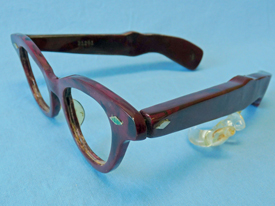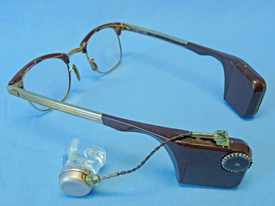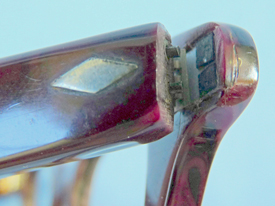by Neil Bauman, Ph.D.
November 8, 2016
The concept of a CROS (Contralateral Routing Of Sound [or Signal]) hearing aid is simple. Route the sound from the “deaf” (worse hearing) ear to the “good” (better hearing) ear. The result is that people who are deaf or hard of hearing in one ear can now better hear what people are saying from their “deaf” side.
Harry Teder of Telex Corp. patented this concept back in 1964, and the first CROS aids were fitted the following year. (1) This is all well and good, but the truth is, CROS hearing aids had already been in use for 10 years by this time without anyone even realizing it! Let me explain.
With the invention of the transistor and its first use in hearing aids beginning in December, 1952, hearing aids rapidly shrank in size. This was because transistors, even the early ones, were still much smaller than the miniature vacuum tubes they replaced. In addition, eliminating vacuum tubes also eliminated the large “B” battery that these vacuum tubes required to “run”.
The result was that just 2 years after the first hearing aid containing a transistor came out—the body-worn Sonotone Model 1010—hearing aids had shrunk so much that the electronic components could now be hidden inside the temple-pieces of eyeglasses.
However, the components were still too large to all fit into just one temple-piece, so the manufacturers put some components in each temple-piece. The four biggest components were the microphone, volume control, receiver and battery. They put the microphone, volume control and electronics in one temple-piece and the receiver and battery in the other.
This arrangement had a big advantage. It totally eliminated feedback as the microphone and receiver were separated by 7” or 8” (18 – 20 cm) and were on the opposite sides of the head. However, by using this arrangement, the result was, in actuality, a CROS aid—the sound was picked up from one side of the head and delivered to the opposite ear.

Fig. 1. Otarion Model L10 “Listener” eyeglass hearing aid—the world’s first transistorized eyeglass hearing aid. Note the thick, heavy temple-pieces. Both were needed for this hearing aid.
Otarion introduced the first eyeglass hearing aid using transistors, their Model L10 “Listener” (Fig. 1), on December 9, 1954. It went on sale in January, 1955 and thus had the distinction of being the first CROS aid—a decade before the concept was supposedly invented.
These new eyeglass CROS hearing aids quickly became popular and by 1961 no less than 33 different hearing aid manufacturers had come out with their own versions of these CROS eyeglass hearing aids.
Interestingly enough, there were two basic styles used in these early CROS eyeglass hearing aids. The first style had large, heavy-looking temple-pieces with the electronics housed throughout their length. An example of this style was the Otarion L10 “Listener” (shown above).
Fig. 2. The Acousticon Model A-230 eyeglass hearing aid showing how the electronics were all contained in the tips of the temple-pieces.
The second style had more or less regular-looking temple-pieces with the hearing aid electronics all housed in the temple-piece tips behind the ear. Thus from the front and side, these hearing-aid eyeglasses looked “normal” and the hearing aid part was generally invisible—buried in the hair. An example of this style was Acousticon’s first eyeglass hearing aid, their Model A-230 that came out in 1955 (Fig. 2).
As you can see, instead of having the electronics spread through the length of the temple-pieces, they gathered them all into two enormous (by today’s standards) behind the ear tips of the temple-pieces. The microphone, electronics and volume control were housed in the right temple-piece while the battery and receiver were housed in the left one (Fig. 2).

Fig. 3. Radioear’s Model 840 “Lady America” eyeglass hearing aid. In this case the receiver, volume control and electronics were in the left temple piece and the batter and microphone in the right one. They could be unplugged and interchanged at will.
Not to be outdone, Radioear came out with their Model 840 “Lady America” eyeglass hearing aid (Fig. 3) in a similar style but with a twist. You could unplug the two parts of this hearing aid from the temple-pieces, plug them into each other (along with the aluminum face-plate) and voilà—you had a body or barrette hearing aid (Fig. 4).

Fig. 4. The Radioear Model 840 eyeglass hearing aid pulled apart to make a body-worn hearing aid. The aluminum face-plate (left) was sandwiched between the two parts.
One problem the engineers had to overcome was how to send the sound signals and power from one temple-piece to the other. Their solution was to run two wires from the frame end of the temple-piece across the frame and nose bridge to the opposite temple-piece. To do this, they used one of two methods. The simplest way was to design the frames with a groove—typically across the top of the lenses and the

Fig. 5. Radioear Model 840 eyeglass hearing aid showing how the wire threaded around the hinge and fitted into a groove along the top of the frames.
inside of the bridge to the other side. The wires could be “loose” at the hinge (Fig. 5) or more hidden. The weak point with this arrangement was that opening and closing the glasses each day could cause the wires to break at the hinge.
A more elegant solution was to make the wires in three sections—one for each temple-piece and one for the eyeglass frames. To make contact with each other at the hinge, they used an ingenious arrangement of two pins

Fig. 6. Close-up view of the hinge area of the Otarion Model L10 eyeglass hearing aid showing the black “pins” (left) and “plates” (right).
and two plates (Fig. 6). When the glasses were folded, the pins and plates didn’t touch so it automatically turned the hearing aid off. When you opened the glasses to wear them, the pins touched the plates again and turned the hearing aid on.
One drawback of needing both temple-pieces is that you could not have a binaural fitting. This didn’t seem to be too much of a problem in the mid-1950s as they seldom used binaural fittings at that time. They figured that hearing in one ear was good enough.
Fig. 7. The Acousticon Model A-235 eyeglass hearing aid only required one temple-piece. This is an example of the first hearing aid to have a separate hearing aid in each temple-piece.
However, it didn’t take long for components to shrink further, and by October, 1956 both Acousticon and Beltone had come out with eyeglass hearing aids that had all the components in just one temple-piece. Notice that the Acousticon Model A-235 (Fig. 7) and the Beltone “Hear-N-See” (Fig. 8) still had the heavy-looking

Fig. 8. The Beltone Hear-N-See eyeglass hearing aid was another early hearing aid that only required one temple-piece. This example also had a separate hearing aid in each temple-piece—quite a rare occurrence back in the mid-1950s.
temple-pieces—it’s just that all the components were contained in one temple-piece. The opposite temple-piece could be a separate hearing aid (shown in Figs. 7 and 8), or it could be a matching “dummy”. Now people could wear binaural eyeglass hearing aids.
Thus, the demise of the early eyeglass CROS hearing aids began within 2 years of their first coming out. By 1958 almost all eyeglass hearing aids only used one temple-piece, although bone conduction eyeglass CROS hearing aids requiring both temple-pieces stuck around a bit longer—until 1961 or so.
So that is how CROS hearing aids existed a decade before CROS aids were invented. As Paul Harvey used to say, “Now you know the rest of the story”.
_______
(1) Chasin, Marshall, Au.D. Obituary: The CROS Hearing Aid (1964-2014). Hearing Review. Vol. 21, No. 5. May, 2014.
Neil Bauman, Ph.D. is the owner/curator of The Hearing Aid Museum.

I need a BiCros. I’ve tried 3 brands with 2 different audiologists.My hearing loss is the upper frequency. All I want is to hear without an echo , hyperacusis, or white noise. No one seems to be able to make this happen. Am I expecting too much? I don’t expect normal hearing, just an improvement. I live in a fairly rural area, so my options are limited. Any pointers would be greatly appreciated. Thank you.
Hi Marie:
Tell me more about your hearing loss and other symptoms such as the hyperacusis. How bad is it. Do you have tinnitus? And how bad is it.
What is the problems you are having with the Bicros aids. How come you are getting an echo? Do they have white noise generators built-in. Is the hyperacusis only when you wear the aids or do you have it all the time?
Cordially,
Neil
Thank you for responding.
I have no idea why the hearing aids echo. They didn’t at the start, but once the volume was increased because I needed more sound, the echo began. The echo was mainly my own voice, which made speaking tricky, but also sometimes with TV and movies or podcasts . The white noise happens in the car, every time the heat or an appliance goes on in the house, in a noisy environment, in the grocery, etc. In short it happens any place that isn’t dead quiet. My last visit to audiologist I was told I could live with the echo the hearing aids cause, or live with the white noise they produce every time there is any noise in the background. I can’t live with either choice, so I returned the hearing aids because she couldn’t get rid of the white noise.
Hyperacusis happens only when wearing the hearing aids. This didn’t happen at low volume either. It seems my only choice is to keep hearing aids at a low volume that isn’t very helpful.
I have mild tinnitus that I can manage, as it’s intermittent, but the white noise from the hearing aids made it very much worse. The white noise also triggered migraines, and made it impossible to hear.
Again, thank you for your time and expertise!
My father had glasses with hearing aids built-in to the stems holding the glasses. He never complained about them as I remember. Now when I need to wear hearing aids I would like to have similar type glasses like my father had. As you know such glasses are not available today regardless of the far ad-vanced technology of today. Why are hearing aid companies not working with eyeware firms to make this product available. I know there is a demand for this. I am one who would buy this now if it were only available. Can we perhaps get government to encourage development of this?
Hi Morry:
Back in the 1960s I wore eyeglass hearing aids so I know what they are like. They were quite popular from about the mid 1950s to into the 1970s when they fell out of favor. A couple of companies tried to revive them, but they never caught on.
There are a couple of real drawbacks to having eyeglass hearing aids. For example, if you need to get new glasses, you have to send your eyeglass hearing aids away for a week or so–and during that time, you can’t hear. Conversely, if you hearing aids need to be sent away for repairs, then you can’t see. That is a real problem and there is no easy way to overcome it.
It is much better to have them separate so as new models of hearing aids come out, you don’t have to come up with new shapes of eyeglasses. And every company wants their hearing aids (and eyeglasses) to have their own style, Thus, the eyeglass hearing aids are proprietary and there are not enough people wanting a given manufacturer’s hearing aids in eyeglasses to make it worthwhile to produce them. There lose the economies of scale.
And sometimes you may want to just hear and not wear your glasses, or vice versa. For example, you are playing around in the water and want to see, but don’t want to get your hearing aids wet. Or if you are like me and how two pairs of glasses–now I need two pairs of hearing aids and that costs thousands of dollars more.
So, because of the above, I don’t see eyeglass hearing aids making a comeback. Furthermore, hearing aids are much smaller now so there is more room behind your ears for both hearing aids and eyeglasses. And if you wear in-the-ear hearing aids, there is no competition for space behind your ears.
Cordially,
Neil